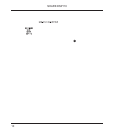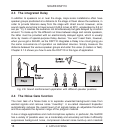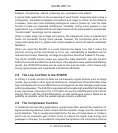
17
SHARK DSP110
2.2 The Feedback Destroyer in the SHARK
The SHARK identifies feedback by splitting the entire frequency spectrum (20 Hz to
20 kHz) into sections of 1/60 of an octave and determining the level of each of these
bands. The values calculated are then referenced to the level of the overall signal. The
resulting level difference determines whether or not a filter is set. The SHARK allows
you to adapt these decisive parameter to your needs: within a range from 1 through
100 you can edit the feedback detection sensitivity. The standard setting is 50, which
ensures the best possible detection of feedback for the majority of applications. For
speech-only applications you can raise the feedback detection threshold towards 100,
which enables the algorithm to detect and remove feedback even more quickly. Vice
versa, lower values provide for a more stable feedback suppression responding less to
wanted feedback-like signal portions produced by guitars or keyboards.
In FILTER LEARN mode, feedback is generated and suppressed automatically.
Whenever it detects feedback, the DSP110 selects the filter parameters automatically
to efficiently remove the feedback. As the filter is set to the frequency detected, this
mode is ideally suitable for suppressing constant feedback frequencies produced by
fixed microphones, e.g. those used on drums. Once set, the filters automatically enters
lock mode, i.e. the frequency remains fixed but width and depth of the filter are still
being adapted to the signal. The filter width is enlarged whenever the feedback frequency
shifts slightly. If feedback persists, gain is reduced even more and kept low to prevent
feedback from recurring.
All microphones that are moved during a performance (e.g. hand-held vocal
microphones) are usually susceptible to varying feedback frequencies, which should
be suppressed in automatic search mode (entered when you power up the SHARK).
Much like in FILTER LEARN mode, a filter automatically determines the ideal settings
for all parameters, in order to suppress feedback. However, once all filters have been
set, the filter first activated gets reset to automatic search mode. Thus, the SHARK
makes sure that there is always one free filter to identify and remove new feedback
frequencies. If your music contains wanted feedback elements (e.g. guitar feedback),
the SHARK will suppress these too, because it is impossible from a physical point of
view to distinguish wanted from unwanted feedback. Section 2.1.6 provides some
information on how to get around this physical problem.
2. APPLICATIONS


















